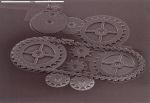EPJ B Highlight - Revisiting quantum effects in MEMS
- Details
- Published on 12 November 2013

New calculations shows that the influence of quantum effects on the operating conditions of nanodevices has, until now, been overestimated
Micro- and nano-electromechanical devices, referred to as MEMS and NEMS, are ubiquitous. These nanoscale machines with movable parts are used, for example, to trigger cars’ airbags following a shock. They can also be found in smartphones, allowing them to detect how to adequately display the screen for the viewer. The trouble is that, as their size decreases, forces typically experienced at the quantum level start to matter in these nanodevices. Mexican physicists have studied the mechanical and electrical stability of MEMS and NEMS, depending on the plate thickness and the nature of the material used. The results have now been published in EPJ B by Raul Esquivel-Sirvent and Rafael Perez-Pascual from the National Autonomous University of Mexico, in Mexico City.
Forces of quantum origin become important at the scale of these devices shrinks; this is particularly true for the so-called Casimir force. This force leads to van der Waals interactions, which represent the sum of all intra-molecular interactions. These include attractions and repulsions between atoms, molecules, and surfaces, as well as other intermolecular forces, and are caused by correlations in the fluctuating polarisations of nearby particles.
To investigate the stability of nanodevices, Esquivel-Sirvent and his colleague used the classical calculation of the Casimir force, referred to as the Lifshitz formula, combined with the theory of stability of micro- and nanoscale machines.
In this study, the authors show that previous works overestimated the operating conditions of the devices by not taking into account this Casimir/van der Waals effect.
In addition, they demonstrate that the stability of these devices under the Casimir force changes depending on the nature and thickness of the metal coatings used. It also depends on the variation of concentration of the free charges in the silicon used, which changes with doping levels.
R. Esquivel-Sirvent and R. Perez-Pascual (2013), Geometry and charge carrier induced stability in Casimir actuated nanodevices, European Physical Journal B, DOI 10.1140/epjb/e2013-40779-5




